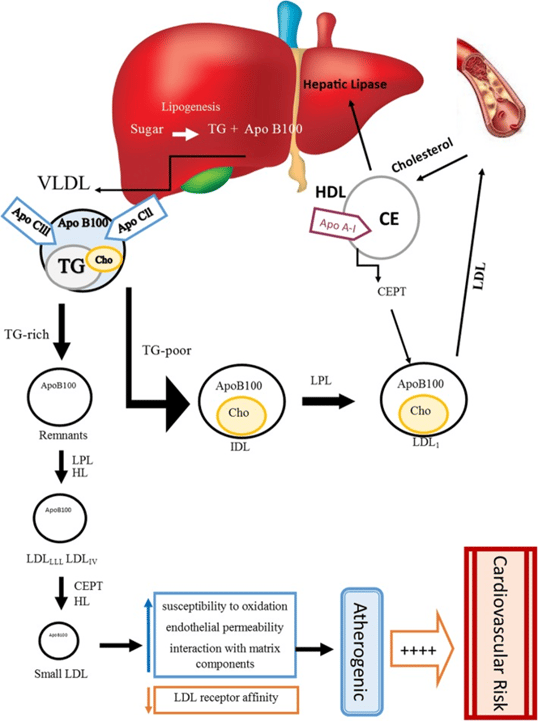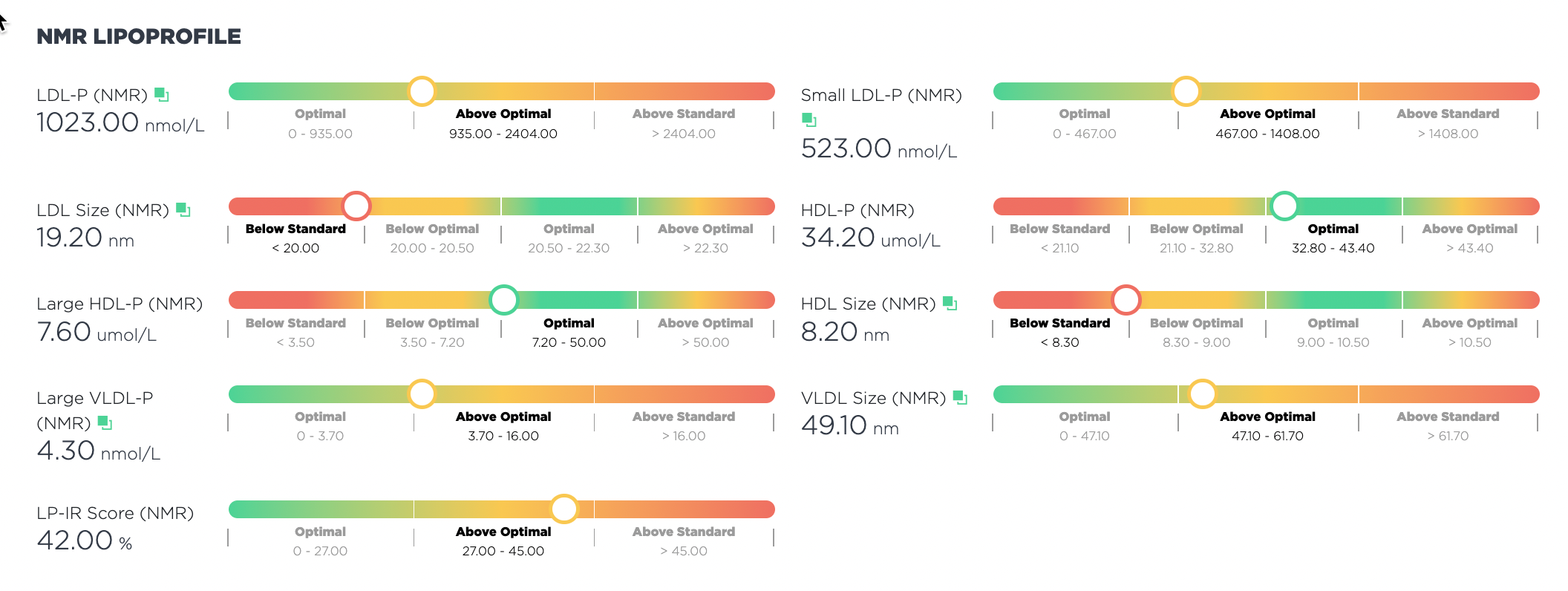What is NMR?
NMR stands for Nuclear Magnetic Resonance. It is a method commonly used to take a closer look at the lipoproteins that carry cholesterol, triglycerides, antioxidants, and other compounds through the blood. This technology allows for the assessment of the size, density, and particle number of different lipoprotein classes, i.e., VLDL, LDL, IDL, and HDL.
The NMR method “quantitatively measures the spectral signals generated by the terminal methyl groups on lipids within lipoprotein particles. Unlike most other methods, NMR spectroscopy does not require physical separation of lipoproteins” (AACC 2017).
The subclasses assessed in the NMR report include: (Ivanova 2017)
- Very-low density lipoprotein (VLDL)
- VLDL1 Larger, high in triglycerides, converted to sdLDL, associated with insulin resistance (Gill 2004)
- VLDL2 Smaller, lower in triglycerides
- Low-density lipoprotein (LDL)
- LDL1: Large buoyant particles, pattern A phenotype, peak LDL particle size greater 25.5 nm
- LDL2: Intermediate particles, pattern A phenotype, peak LDL particle size greater 25.5 nm
- LDL3 and LDL4: Small dense (sdLDL) particles 18-20.5 nm via NMR; pattern B phenotype; contain more triglycerides and less cholesterol; contain fewer antioxidant nutrients and are more prone to oxidation, glycation, and desialylation; have longer circulation time, and are more apt to promote atherosclerosis.
The NMR method is able to differentiate the sizes of high-density lipoprotein particles (HDL) as well. A larger HDL particle size (9.4-14 nm) is associated with a lower risk of CVD while a smaller HDL particle size (7.3-8.2 nm) is associated with increased CVD risk (Parra 2014).

Source: Talebi, Sepide et al. “The beneficial effects of nutraceuticals and natural products on small dense LDL levels, LDL particle number and LDL particle size: a clinical review.” Lipids in health and disease vol. 19,1 66. 11 Apr. 2020, doi:10.1186/s12944-020-01250-6 This article is licensed under a Creative Commons Attribution 4.0 International License, http://creativecommons.org/licenses/by/4.0/.
Some Answers to Common Questions Regarding NMR
What do the results of the NMR lipoprotein subfractionation mean?
Lipoprotein subfractionation goes “way way” beyond total cholesterol testing which is unable to identify the majority of individuals who develop cardiovascular disease (AACC 2017). Lipoprotein subfractionation is also superior to just measuring or calculating the amount of cholesterol carried by LDL or HDL. The more detailed breakdown of lipoprotein particle size and number (subfractionation) provides information about the atherogenicity of the lipoproteins and their cargo and can help predict cardiovascular risk even in those who may traditionally be considered low risk. Identifying and quantifying small dense LDL particles (sdLDLs) is especially useful as their presence triples the risk of coronary heart disease (Superko 2009).
Is sdLDL the same as sdLDL-C?
No, sdLDL refers to the lipoprotein particle itself while sdLDL-C refers to the amount of cholesterol carried on the small dense LDL particle.
Where can you order NMR lipoprotein subfractionation?
Commercial labs such as Quest Diagnostics (via Cleveland Heart Labs) and Labcorp (LipoProfile®) offer NMR lipoprotein subfractionation as do some direct access lab services.
Is NMR the same as Ion Mobility or other methods of lipoprotein subfractionation, e.g. the Cardio IQ® test?
No, the NMR method of lipoprotein subfractionation is different from other methods such as ion mobility analysis, ultracentrifugation, gradient gel electrophoresis, high-performance liquid chromatography (HPLC) with gel filtration columns, dynamic light scattering, and homogenous assay. The NMR method is FDA approved (AACC 2017) and is the least labor-intensive method of measuring lipoprotein subfractions (Langlois 2018).
The ion mobility method uses mass spectroscopy via gas-phase differential electrical mobility to measure lipoprotein size and concentration. The ion mobility method requires more time and more extensive methodology than NMR (AACC 2017).
Ion mobility lipoprotein subfractionation for LDL and HDL is available from Quest Diagnostics as the Cardio IQ® test which also assesses total, LDL, HDL, and non-HDL cholesterol, as well as ApoB, and Lp(a). According to Quest (Quest 2018):
- The ion mobility-derived total, small, and medium LDL subclass concentrations (nmol/L) reflect direct detection and quantitation of the number of LDL particles.
- In contrast, the nuclear magnetic resonance (NMR)-derived LDL particle number (LDL-P, nmol/L) includes the 3 LDL subclasses (small, medium, total LDL) and IDL. The concentration is measured indirectly from NMR signals emanating from terminal methyl groups from all different lipid classes (triglycerides, cholesterol ester, unesterified cholesterol, and phospholipids) in the lipoprotein particle shell and core.
Lastly, are the NMR Lipoprotein Subfractionation Biomarkers in the ODX software?
Yes!
Feel free to add results for these biomarkers into the software. Lab importing will pull the results in and we have added all 9 biomarkers to the default templates.

Lipoprotein Subfractionation: LDL Particle Number (NMR)
Lipoprotein Subfractionation: Small Dense LDL Particles (NMR)
Lipoprotein Subfractionation: LDL Particle Size (NMR)
Lipoprotein Subfractionation: HDL Particle Number (NMR)
Lipoprotein Subfractionation: Large HDL Particle Concentration (NMR)
Lipoprotein Subfractionation: HDL Size (NMR)
Lipoprotein Subfractionation: Large VLDL Particle Number (NMR)
Lipoprotein Subfractionation: VLDL Size (NMR)
Biomarkers of Glucose Regulation: Lipoprotein Insulin Resistance Index LP-IR
References
American Academy of Clinical Chemists (AACC). Lipoprotein Subfractionation Analysis: The Continuing Quest for Improving Cardiovascular Risk Prediction. January 3, 2017.
Gill, Jason M R et al. “Hepatic production of VLDL1 but not VLDL2 is related to insulin resistance in normoglycaemic middle-aged subjects.” Atherosclerosis vol. 176,1 (2004): 49-56. doi:10.1016/j.atherosclerosis.2004.04.022
Ivanova, Ekaterina A et al. “Small Dense Low-Density Lipoprotein as Biomarker for Atherosclerotic Diseases.” Oxidative medicine and cellular longevity vol. 2017 (2017): 1273042. doi:10.1155/2017/1273042
Langlois, Michel R et al. “Quantifying Atherogenic Lipoproteins: Current and Future Challenges in the Era of Personalized Medicine and Very Low Concentrations of LDL Cholesterol. A Consensus Statement from EAS and EFLM.” Clinical chemistry vol. 64,7 (2018): 1006-1033. doi:10.1373/clinchem.2018.287037
Liou, Lathan, and Stephen Kaptoge. “Association of small, dense LDL-cholesterol concentration and lipoprotein particle characteristics with coronary heart disease: A systematic review and meta-analysis.” PloS one vol. 15,11 e0241993. 9 Nov. 2020, doi:10.1371/journal.pone.0241993
Parra, Eliane Soler et al. “HDL size is more accurate than HDL cholesterol to predict carotid subclinical atherosclerosis in individuals classified as low cardiovascular risk.” PloS one vol. 9,12 e114212. 3 Dec. 2014, doi:10.1371/journal.pone.0114212
Quest Diagnostics Cardio IQ® Ion Mobility. 2018.
Superko H. R. (2009). Advanced lipoprotein testing and subfractionation are clinically useful. Circulation, 119(17), 2383–2395.
Talebi, Sepide et al. “The beneficial effects of nutraceuticals and natural products on small dense LDL levels, LDL particle number and LDL particle size: a clinical review.” Lipids in health and disease vol. 19,1 66. 11 Apr. 2020, doi:10.1186/s12944-020-01250-6







